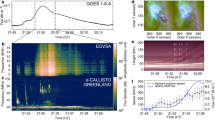Abstract
We discuss pulsar glitch dynamics from three different viewpoints: statistical description, neutron star equation of state description and finally an electromagnetic field description. For the latter, the pulsar glitch recovery times are the dissipation time constants of sheet surface currents created in response to the glitch-induced crustal magnetic field disruption. We mathematically derive these glitch time constants (Ohmic time constant and Hall sheet current time constant) from a perturbation analysis of the electromagnetic induction equation. Different crustal channels will carry the sheet surface current and their different electron densities determine the time constants.



Similar content being viewed by others
Notes
At the time of the prediction, PSR 1259-63 had no history of glitches.
Any hypothetical nucleon pairing leading to a supposed nuclear super-fluid, takes fermions from high momentum states and puts them in a bound boson state of lowest energy, e.g. Haskell and Melatos (2015), Lyne and Graham-Smith (2006). A boson equation of state cannot support the star against its own gravity and this constitutes a fundamental error in physics.
See for example, Fig. 4 of Seager et al. (2007).
We ignore the very tiny eccentricity.
The surface of a neutron star is a mosaic of platelets whose boundaries are crystal defects. Accretion induced collapse is itself a field of study, e.g. Giacomazzo and Perna (2012).
The ensuing platelet connected avalanche means that a given platelet may fall inward more than once (Morley and Schmidt 1996).
In actual fact, most platelet avalanches are not \(4\pi\) steradian symmetric and a radius change is just an approximation; however, these non-\(4\pi\) avalanches would be expected to produce a measurable pulsar wobble.
Steady-state mechanical failures of neutron star crusts is studied in Levin and Lyutikov (2012).
References
Archibald, R.F., et al.: Astrophys. J. Lett. 819, L16 (2016). doi:10.3847/2041-8205/819/1/L16
Bak, P.: How Nature Works: The Science of Self-Organized Criticality. Copernicus, New York (1996)
Bak, P., Tang, C., Wiesenfeld, K.: Phys. Rev. A 38, 364 (1988). doi:10.1103/PhysRevA.38.364
Chamel, N., Haensel, P.: Living Rev. Relativ. 11, 10 (2008). doi:10.12942/lrr-2008-10
Demiański, M., Prószyński, M.: Mon. Not. R. Astron. Soc. 202, 437 (1983)
Dodson, R.G., McCulloch, P.M., Lewis, D.R.: Astrophys. J. 564, L85 (2002)
Giacomazzo, B., Perna, R.: Astrophys. J. 758, L8 (2012)
Gourgouliatos, K.N., Cumming, A.: Mon. Not. R. Astron. Soc. 446(1), 1121–1128 (2015). doi:10.1093/mnras/stu2140
Gutenberg, B., Richter, C.F.: Seismicity of the Earth and Associated Phenomena, 2nd edn. Princeton University Press, Princeton (1954)
Harnden, F.R. Jr., Seward, F.D.: Astrophys. J. 283, 279–285 (1984). doi:10.1086/162304
Harnden, F.R. Jr., et al.: Astrophys. J. 299, 828–838 (1985). doi:10.1086/163749
Harutyunyan, A., Sedrakin, A.: Phys. Rev. C 94, 025805 (2016). doi:10.1103/PhysRevC.94.025805
Haskell, B., Melatos, A.: Int. J. Mod. Phys. D 24, 1530008 (2015). doi:10.1142/s0218271815300086
Helfand, D.J., Gotthelh, E.V., Halpern, J.P.: Astrophys. J. 556, 380 (2001)
Ho, W.C.G.: Mon. Not. R. Astron. Soc. 452(1), 845–851 (2015). doi:10.1093/mnras/stv1339
Johnston, S., Wang, N., Manchester, D.: Binary Radio Pulsars. ASP Conference Series, vol. 328. Astronomical Society of the Pacific, San Francisco (2005)
Kojima, Y., Kisaka, S.: Mon. Not. R. Astron. Soc. 421(3), 2722–2730 (2012). doi:10.1111/j.1365-2966.2012.20509.x
Lattiner, J.M.: Annu. Rev. Nucl. Part. Sci. 62, 485–515 (2012). doi:10.1146/annurev-nucl-102711-095018
Levin, Y., Lyutikov, M.: Mon. Not. R. Astron. Soc. 427(2), 1574–1579 (2012). doi:10.1111/j.1365-2966.2012.22016.x
Lyne, A.G., Graham-Smith, F.: Pulsar Astronomy, 3rd edn. Cambridge University Press, Cambridge (2006)
Morley, P.D.: Astron. Astrophys. 313, 204 (1996)
Morley, P.D., García-Pelayo, R.: Europhys. Lett. 23, 185 (1993)
Morley, P.D., Schmidt, I.: Europhys. Lett. 33, 105 (1996)
Potekhin, A.Y.: Phys. Usp. 57, 735 (2014). doi:10.3367/UFNe.0184.201408a.0793
Seager, S., et al.: Astrophys. J. 669, 1279 (2007)
Author information
Authors and Affiliations
Corresponding author
Rights and permissions
About this article
Cite this article
Morley, P.D. Pulsar glitch dynamics. Astrophys Space Sci 363, 5 (2018). https://doi.org/10.1007/s10509-017-3228-3
Received:
Accepted:
Published:
DOI: https://doi.org/10.1007/s10509-017-3228-3




